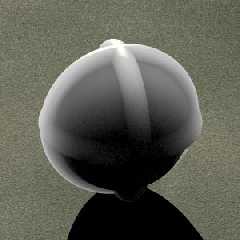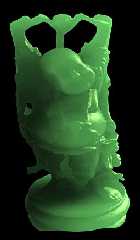 |
 |
|
 |
|
 |
|  |
|  |
|
 |
|
 |
|  |
|  |
|
 |
It's just as I thought..... and I should have done it in the first
place! The solution was obvious..... why hasn't it been done before? At
least I learned a few things from my blob fiasco.
What I'm talking about is the fact that subsurface scattering is 20
times more easy to implement in mlPOV than the official version. The
results are slightly faster and smoother, too. The image you see was
created by the code below:
#declare lpos1=<.5,1,3.25>*100000;
light_source{lpos1,<1.6 1.6 1.1> }
plane{y,-6.75 pigment{bumps scale 25 turbulence .5 lambda 3 poly_wave
.6} normal{granite .2}}
#declare obj=
union{
torus{6,1}
torus{6,1 rotate z*90}
torus{6,1 rotate x*90}
sphere{0,6}
}
object{
obj
pigment{ average
pigment_map{
#local V=0;
#while(V<100)
[1 projection obj ,lpos1 blur .2,10
translate<rand(R)-rand(R),rand(R)-rand(R),rand(R)-rand(R)>*2
color_map { [0 rgb 1][1 rgb 0] }
]
#local V=V+1;
#end
}
}
finish{diffuse 0 ambient 1
specular .5 roughness .05
}
}
--
Samuel Benge
stb### [at] hotmail com
See my website@: http://www.goldrush.com/~abenge/Top/index.html com
See my website@: http://www.goldrush.com/~abenge/Top/index.html
Post a reply to this message
Attachments:
Download 'mlpov_sss.jpg' (19 KB)
Preview of image 'mlpov_sss.jpg'

|
 |
|  |
|  |
|
 |
|
 |
|  |
|  |
|
 |
Beautiful effect.
Post a reply to this message
|
 |
|  |
|  |
|
 |
|
 |
|  |
|  |
|
 |
The object itself looks great. Except it has me looking for a shadow that
matches the translucency. At first I thought maybe an area light could
suffice, somewhat so; but it might not be able to create the right effect
for anything but a simple sphere, for example, I guess.
Bob H.
Post a reply to this message
|
 |
|  |
|  |
|
 |
|
 |
|  |
|  |
|
 |
The bad thing about combining radiosity with averaged samples is that
the radiosity calculation uses each and every one of the samples,
thereby dramatically slowing the rendering process. An area_light would
be an easier fix.
Hughes, B. wrote:
> The object itself looks great. Except it has me looking for a shadow that
> matches the translucency. At first I thought maybe an area light could
> suffice, somewhat so; but it might not be able to create the right effect
> for anything but a simple sphere, for example, I guess.
>
> Bob H.
>
>
>
--
Samuel Benge
stb### [at] hotmail com
See my website@: http://www.goldrush.com/~abenge/Top/index.html com
See my website@: http://www.goldrush.com/~abenge/Top/index.html
Post a reply to this message
|
 |
|  |
|  |
|
 |
|
 |
|  |
|  |
|
 |
I think I prefer the POV 3.5 examples you gave. I think I'll try my
candle again now, I had tried with media but I hope it will be easier
your way.
JC
Samuel Benge wrote:
> It's just as I thought..... and I should have done it in the first
> place! The solution was obvious..... why hasn't it been done before? At
> least I learned a few things from my blob fiasco.
>
> What I'm talking about is the fact that subsurface scattering is 20
> times more easy to implement in mlPOV than the official version. The
> results are slightly faster and smoother, too. The image you see was
> created by the code below:
>
> #declare lpos1=<.5,1,3.25>*100000;
>
> light_source{lpos1,<1.6 1.6 1.1> }
>
> plane{y,-6.75 pigment{bumps scale 25 turbulence .5 lambda 3 poly_wave
> .6} normal{granite .2}}
>
> #declare obj=
> union{
> torus{6,1}
> torus{6,1 rotate z*90}
> torus{6,1 rotate x*90}
> sphere{0,6}
> }
>
> object{
> obj
> pigment{ average
> pigment_map{
> #local V=0;
> #while(V<100)
> [1 projection obj ,lpos1 blur .2,10
> translate<rand(R)-rand(R),rand(R)-rand(R),rand(R)-rand(R)>*2
> color_map { [0 rgb 1][1 rgb 0] }
> ]
> #local V=V+1;
> #end
> }
> }
> finish{diffuse 0 ambient 1
> specular .5 roughness .05
> }
> }
>
>
> ------------------------------------------------------------------------
>
Post a reply to this message
|
 |
|  |
|  |
|
 |
|
 |
|  |
|  |
|
 |
Cool effect ! I had to try it on the happy buddha :)
M
Post a reply to this message
Attachments:
Download 'sss_buddha.jpg' (17 KB)
Preview of image 'sss_buddha.jpg'

|
 |
|  |
|  |
|
 |
|
 |
|  |
|  |
|
 |
On Thu, 27 Nov 2003 18:57:05 +0100, "Mael" <mae### [at] hotmail com> wrote:
> Cool effect ! I had to try it on the happy buddha :)
Indeed, there is no end of fun in good old POV-Ray ;-)
ABX com> wrote:
> Cool effect ! I had to try it on the happy buddha :)
Indeed, there is no end of fun in good old POV-Ray ;-)
ABX
Post a reply to this message
|
 |
|  |
|  |
|
 |
|
 |
|  |
|  |
|
 |
This is the mlPOV technique, yes? Whatever you did, it looks really
good! That buddha statue was just itching to be rendered this way!
Mael wrote:
> Cool effect ! I had to try it on the happy buddha :)
>
> M
>
>
>
--
Samuel Benge
stb### [at] hotmail com
See my website@: http://www.goldrush.com/~abenge/Top/index.html com
See my website@: http://www.goldrush.com/~abenge/Top/index.html
Post a reply to this message
|
 |
|  |
|  |
|
 |
|
 |
|  |
|  |
|
 |
Mael wrote:
>Cool effect ! I had to try it on the happy buddha :)
>
>M
>
indeed.
my first thought was that this could be used to simulate
a translucent jade.
this is way beyond me so i have a couple of questions ...
am i to understand that this particular method of samual's
requires mlpov? i haven't been able to run it with ver 3.5.
and ...
i have been trying to obtain this 'happy buddha'
file but see that it is in "lv" and some other format.
how is it possible to convert these to POV?
or is there somewhere i can find them converted ...
to what ... 'mesh' ?
tia for any leads and help.
ts
Post a reply to this message
|
 |
|  |
|  |
|
 |
|
 |
|  |
|  |
|
 |
ts wrote:
> am i to understand that this particular method of samual's
> requires mlpov? i haven't been able to run it with ver 3.5.
> and ... <break>
There are currently two versions of this technique I have posted to the
newsgroups. The official 3.5 version is in povray.binaries.scenes-files.
The mlPOV version is the one residing in the body of text at the
beginning of this thread.
--
Samuel Benge
stb### [at] hotmail com
See my website@: http://www.goldrush.com/~abenge/Top/index.html com
See my website@: http://www.goldrush.com/~abenge/Top/index.html
Post a reply to this message
|
 |
|  |
|  |
|
 |
|
 |
|  |




![]()